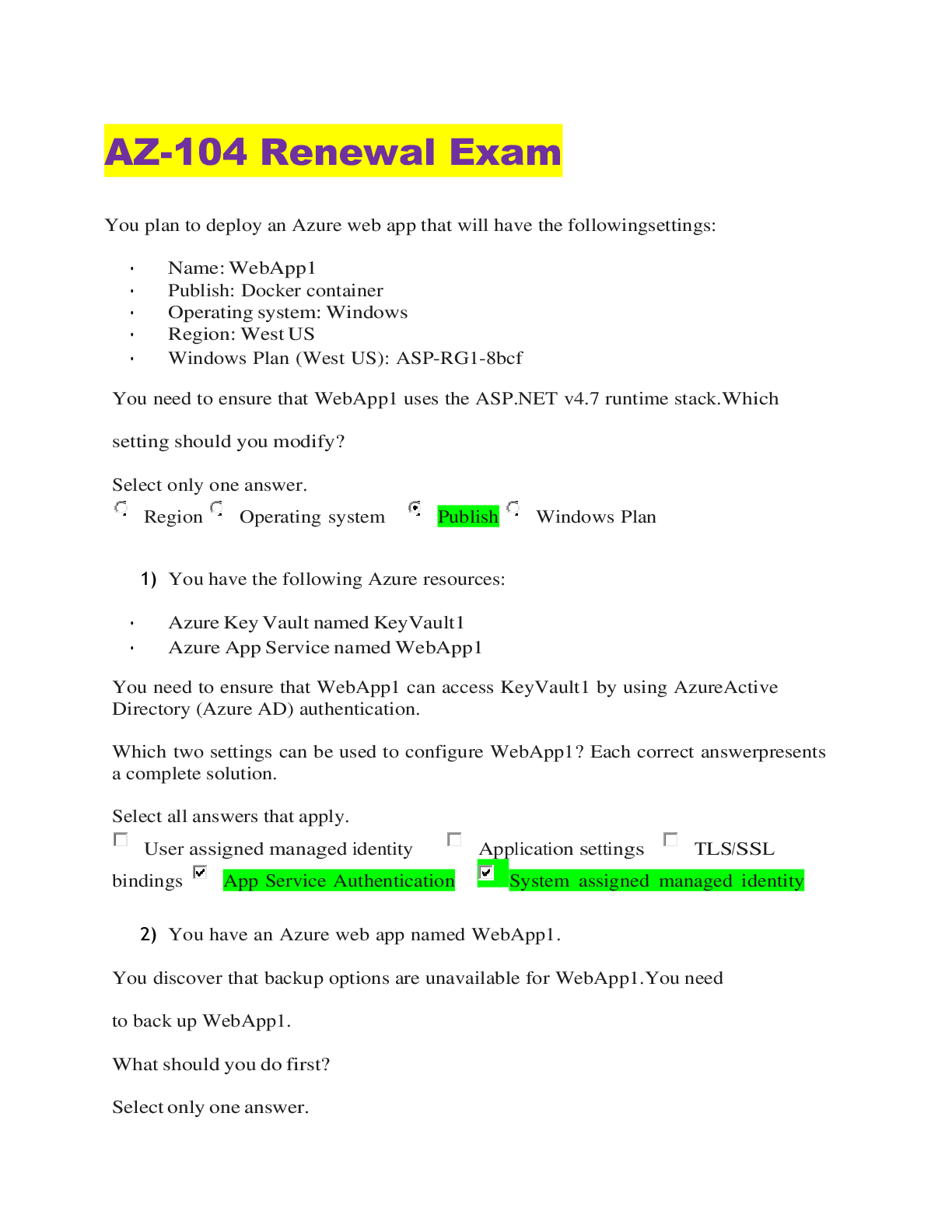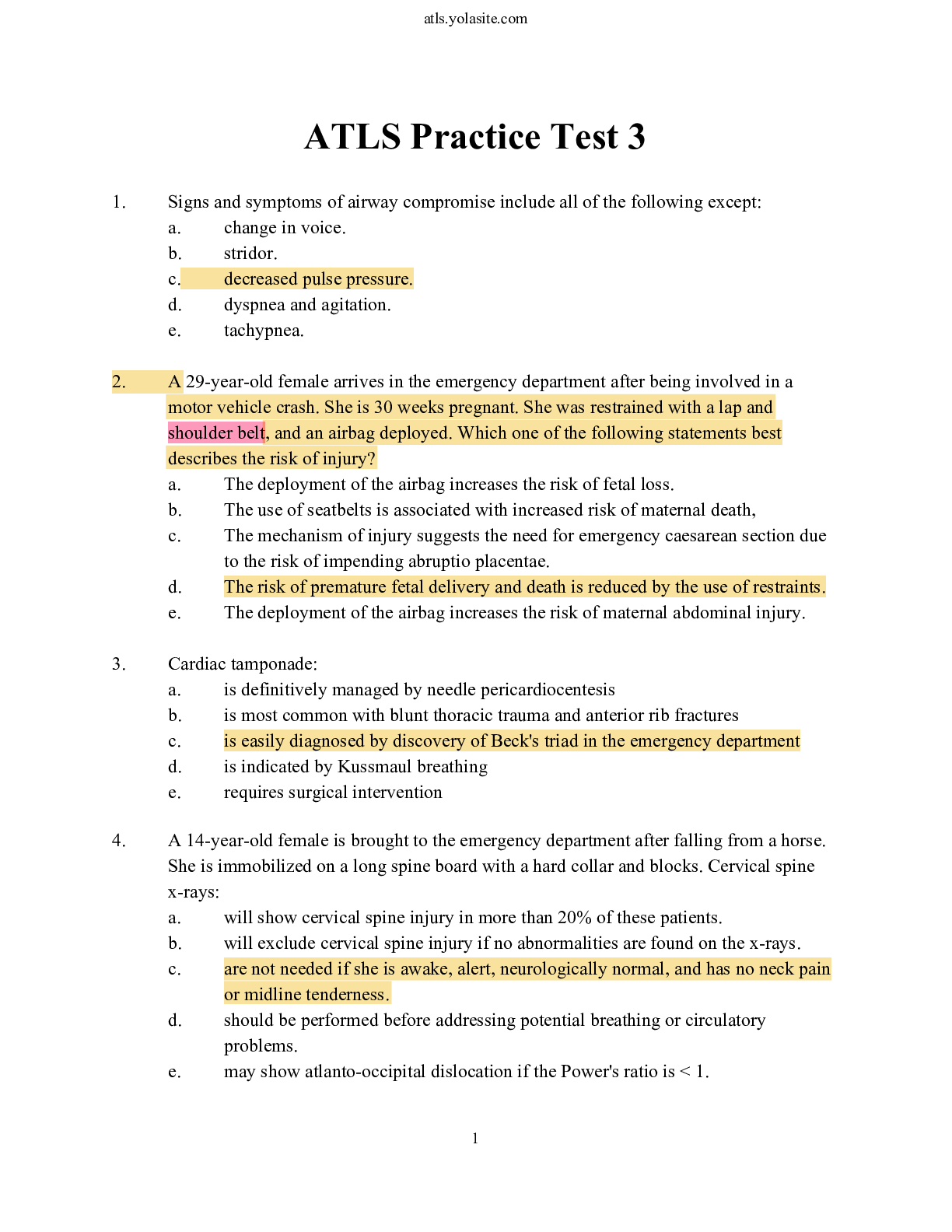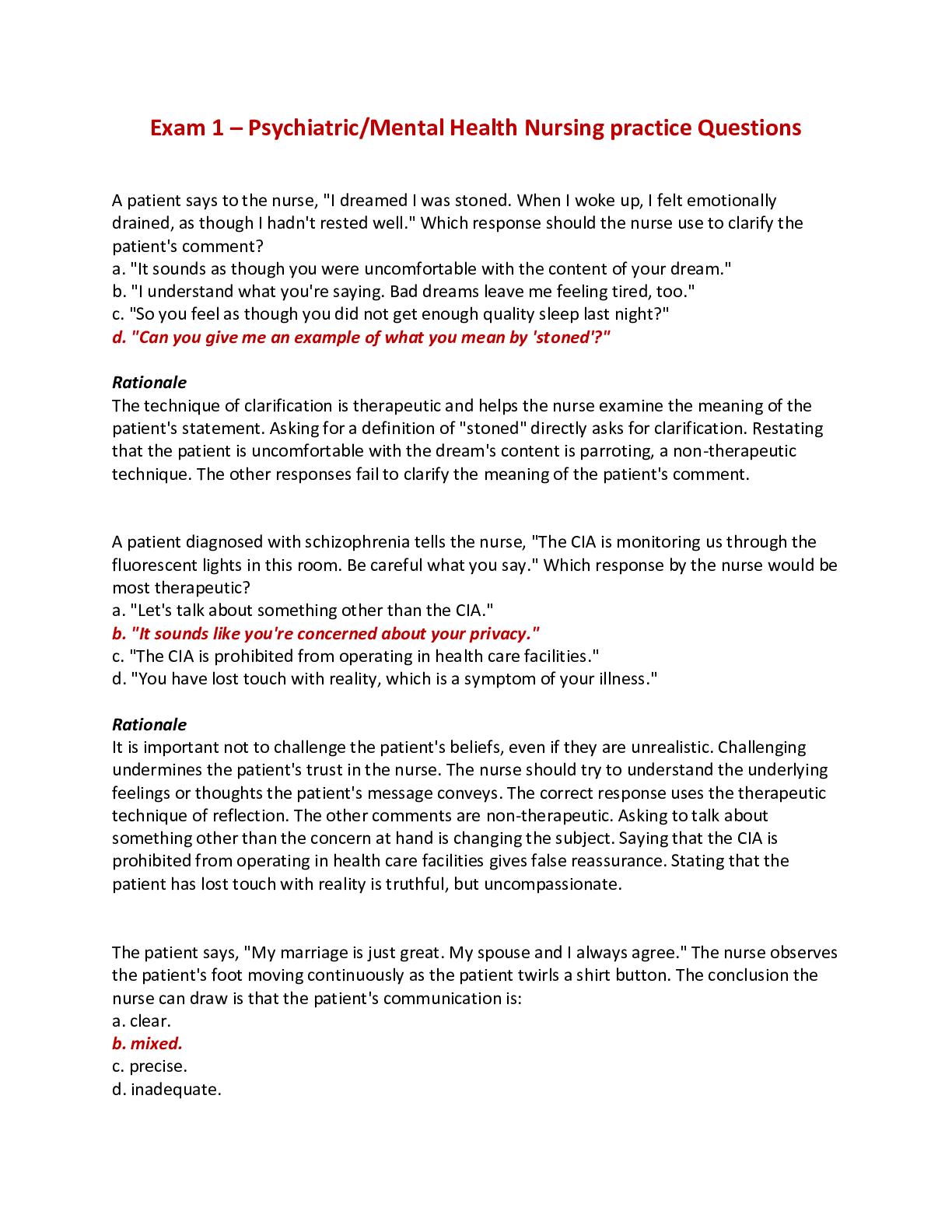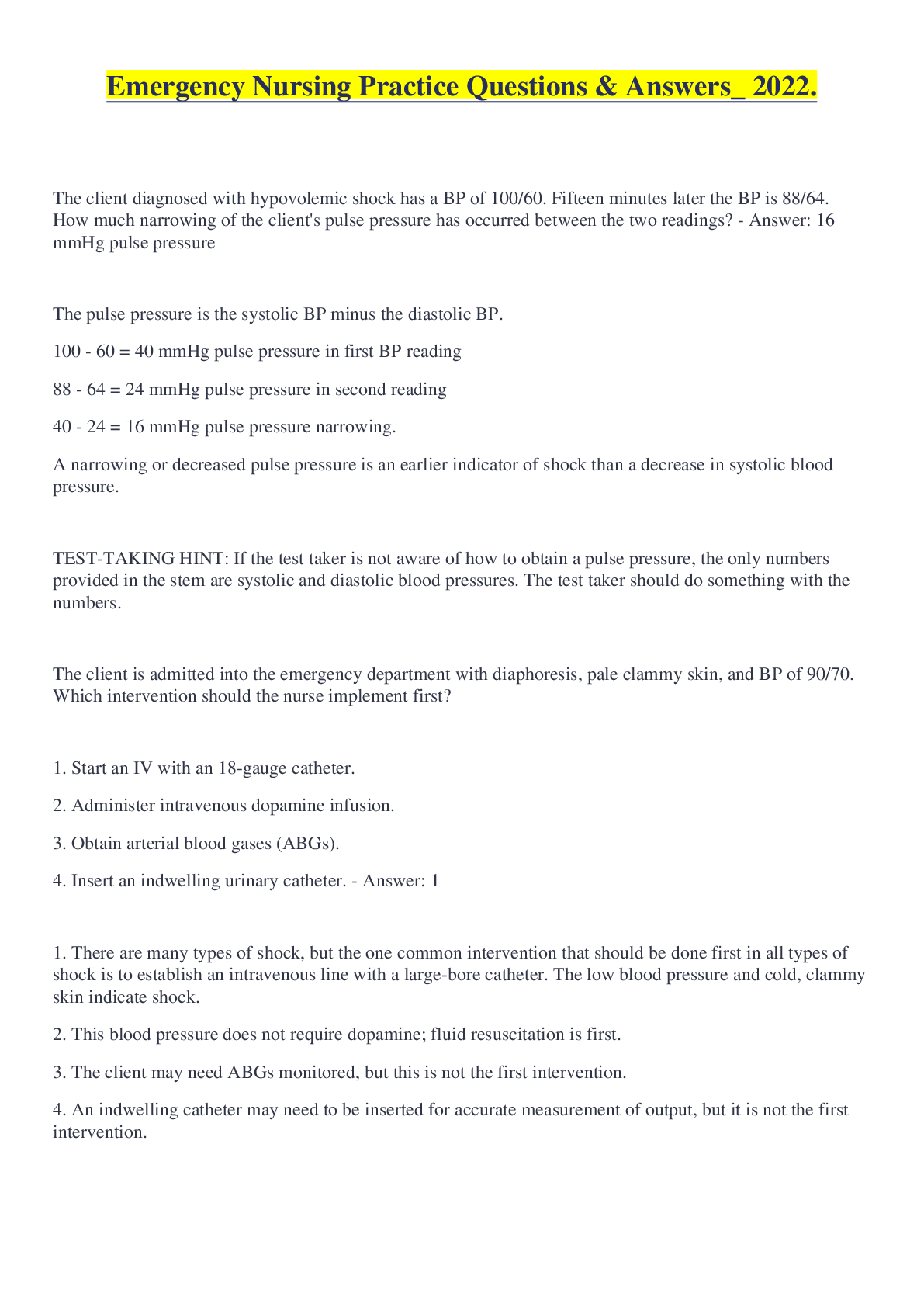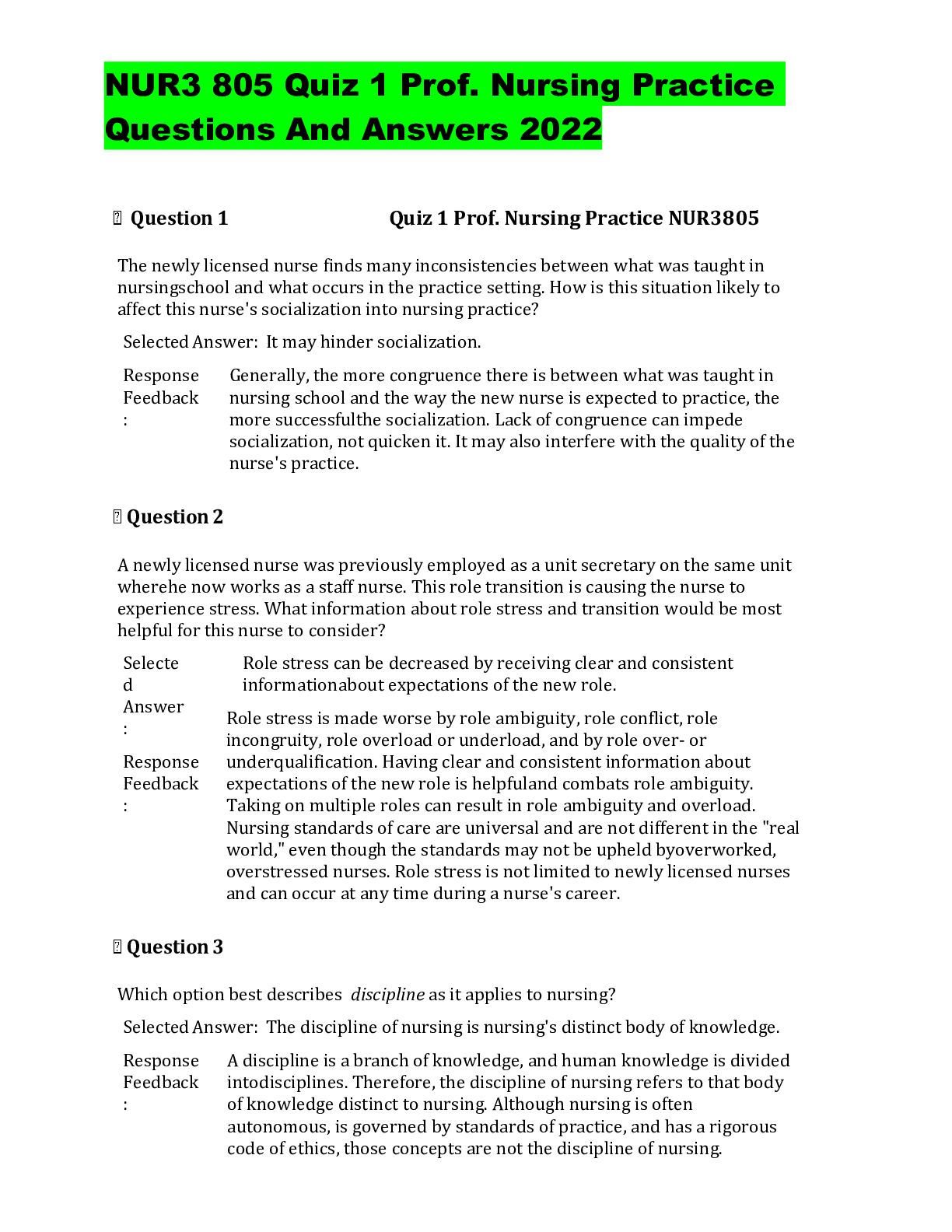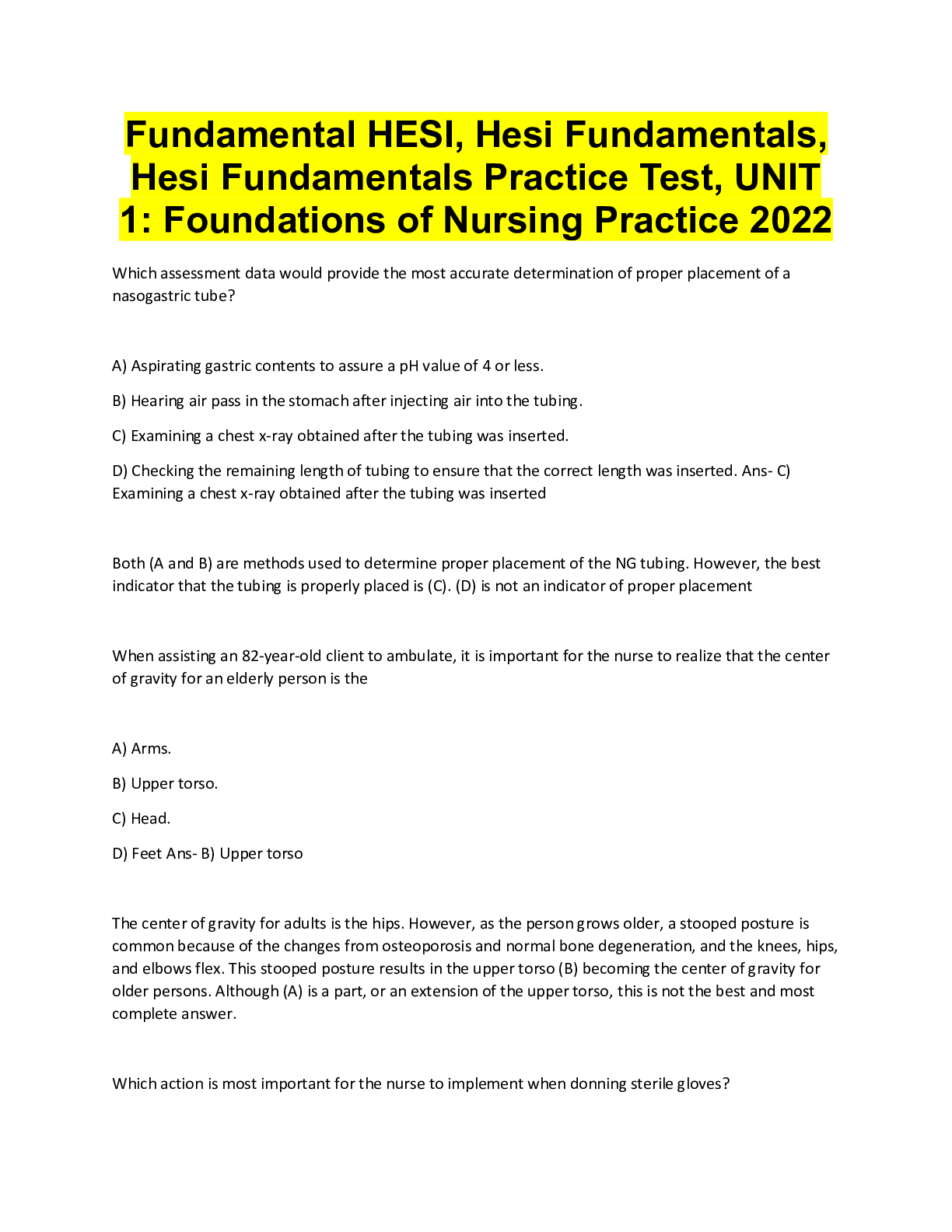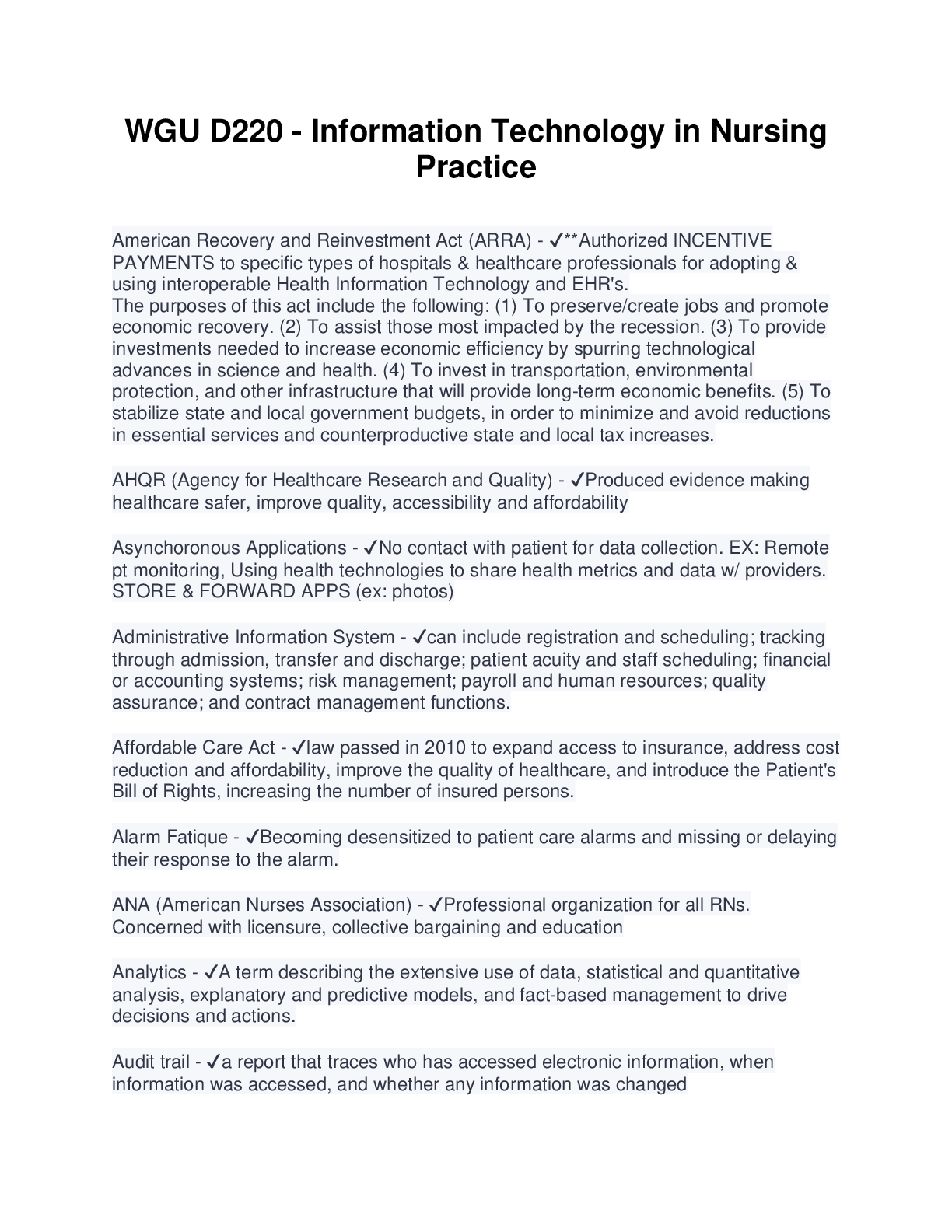Health Care > EXAM > Exam 1 - Psychiatric/Mental Health Nursing practice questions (All)
Exam 1 - Psychiatric/Mental Health Nursing practice questions
Document Content and Description Below
1. A patient says to the nurse, "I dreamed I was stoned. When I woke up, I felt emotionally drained, as though I hadn't rested well." Which response should the nurse use to clarify the patient's comme... nt? a. "It sounds as though you were uncomfortable with the content of your dream." b. "I understand what you're saying. Bad dreams leave me feeling tired, too." c. "So you feel as though you did not get enough quality sleep last night?" d. "Can you give me an example of what you mean by 'stoned'?": ANS: D The technique of clarification is therapeutic and helps the nurse examine the meaning of the patient's statement. Asking for a definition of "stoned" directly asks for clarification. Restating that the patient is uncomfortable with the dream's content is parroting, a non-therapeutic technique. The other responses fail to clarify the meaning of the patient's comment. 2. A patient diagnosed with schizophrenia tells the nurse, "The CIA is mon- itoring us through the fluorescent lights in this room. Be careful what you say." Which response by the nurse would be most therapeutic? a. "Let's talk about something other than the CIA." b. "It sounds like you're concerned about your privacy." c. "The CIA is prohibited from operating in health care facilities." d. "You have lost touch with reality, which is a symptom of your illness.": - ANS: B It is important not to challenge the patient's beliefs, even if they are unrealistic. Challenging undermines the patient's trust in the nurse. The nurse should try to understand the underlying feelings or thoughts the patient's message conveys. The correct response uses the therapeutic technique of reflection. The other comments are non-therapeutic. Asking to talk about something other than the concern at hand is changing the subject. Saying that the CIA is prohibited from operating in health care facilities gives false reassurance. Stating that the patient has lost touch with reality is truthful, but uncompassionate. 3. The patient says, "My marriage is just great. My spouse and I always agree." The nurse observes the patient's foot moving continuously as the patient twirls a shirt button. The conclusion the nurse can draw is that the patient's communication is: a. clear. b. mixed. c. precise. d. inadequate.: ANS: B Mixed messages involve the transmission of conflicting or incongruent messages by the speaker. The patient's verbal message that all was well in the relationship was modified by the nonverbal behaviors denoting anxiety. Data are not present to support the choice of the verbal message being clear, explicit, or inadequate. 4. A nurse interacts with a newly hospitalized patient. Select the nurse's comment that applies the communication technique of "offering self." a. "I've also had traumatic life experiences. Maybe it would help if I told you about them." b. "Why do you think you had so much difficulty adjusting to this change in your life?" c. "I hope you will feel better after getting accustomed to how this unit operates." d. "I'd like to sit with you for a while to help you get comfortable talking to me.": ANS: D "Offering self" is a technique that should be used in the orientation phase of the nurse-patient relationship. Sitting with the patient, an example of "offering self," helps to build trust and convey that the nurse cares about the patient. Two incorrect responses are ineffective and non-therapeutic. The other incorrect response is therapeutic but is an example of "offering hope." 5. Which technique will best communicate to a patient that the nurse is interested in listening? a. Restating a feeling or thought the patient has expressed. b. Asking a direct question, such as "Did you feel angry?" c. Making a judgment about the patient's problem. d. Saying, "I understand what you're saying.": ANS: A Restating allows the patient to validate the nurse's understanding of what has been communicated. Restating is an active listening technique. Judgments should be suspended in a nurse-patient relationship. Close-ended questions such as "Did you feel angry?" ask for specific information rather than showing understanding. When the nurse simply states that he or she understands the patient's words, the patient has no way of measuring the understanding. 6. A patient discloses several concerns and associated feelings. If the nurse wants to seek clarification, which comment would be appropriate? a. "What are the common elements here?" b. "Tell me again about your experiences." c. "Am I correct in understanding that . . ." d. "Tell me everything from the beginning.": ANS: C Asking, "Am I correct in understanding that..." permits clarification to ensure that both the nurse and patient share mutual understanding of the communication. Asking about common elements encourages comparison rather than clarification. The remaining responses are implied questions that suggest the nurse was not listening. 7. A patient tells the nurse, "I don't think I'll ever get out of here." Select the nurse's most therapeutic response. a. "Don't talk that way. Of course you will leave here!" b. "Keep up the good work, and you certainly will." c. "You don't think you're making progress?" d. "Everyone feels that way sometimes.": ANS: C By asking if the patient does not believe that progress has been made, the nurse is reflecting by putting into words what the patient is hinting. By making commu- nication more explicit, issues are easier to identify and resolve. The remaining options are non-therapeutic techniques. Telling the patient not to "talk that way" is disapproving. Saying that everyone feels that way at times minimizes feelings. Telling the patient that good work will always result in success is falsely reassuring. 8. Documentation in a patient's chart shows, "Throughout a 5-minute inter- action, patient fidgeted and tapped left foot, periodically covered face with hands, and looked under chair while stating, 'I enjoy spending time with you.'" Which analysis is most accurate? a. The patient is giving positive feedback about the nurse's communication techniques. b. The nurse is viewing the patient's behavior through a cultural filter. c. The patient's verbal and nonverbal messages are incongruent. d. The patient is demonstrating psychotic behaviors.: ANS: C When a verbal message is not reinforced with nonverbal behavior, the message is confusing and incongruent. Some clinicians call it a "mixed message." It is inaccurate to say that the patient is giving positive feedback about the nurse's communication techniques. The concept of a cultural filter is not relevant to the situation because a cultural filter determines what we will pay attention to and what we will ignore. Data are insufficient to draw the conclusion that the patient is demonstrating psychotic behaviors. 9. While talking with a patient diagnosed with major depression, a nurse notices the patient is unable to maintain eye contact. The patient's chin lowers to the chest, while the patient looks at the floor. Which aspect of communication has the nurse assessed? a. Nonverbal communication b. A message filter c. A cultural barrier d. Social skills: ANS: A Eye contact and body movements are considered nonverbal communication. There are insufficient data to determine the level of the patient's social skills or whether a cultural barrier exists. 10. During the first interview with a parent whose child died in a car accident, the nurse feels empathic and reaches out to take the patient's hand. Select the correct analysis of the nurse's behavior. a. It shows empathy and compassion. It will encourage the patient to contin- ue to express feelings. b. The gesture is premature. The patient's cultural and individual interpreta- tion of touch is unknown. c. The patient will perceive the gesture as intrusive and overstepping bound- aries. d. The action is inappropriate. Psychiatric patients should not be touched.: - ANS: B Touch has various cultural and individual interpretations. Nurses should refrain from using touch until an assessment can be made regarding the way in which the patient will perceive touch. The other options present prematurely drawn conclusions. 11. During a one-on-one interaction with the nurse, a patient frequently looks nervously at the door. Select the best comment by the nurse regarding this nonverbal communication. a. "I notice you keep looking toward the door." b. "This is our time together. No one is going to interrupt us." c. "It looks as if you are eager to end our discussion for today." d. "If you are uncomfortable in this room, we can move someplace else.": - ANS: A Making observations and encouraging the patient to describe perceptions are use- ful therapeutic communication techniques for this situation. The other responses are assumptions made by the nurse. 12. A black patient says to a white nurse, "There's no sense talking. You wouldn't understand because you live in a white world." The nurse's best action wou 1. A patient says to the nurse, "I dreamed I was stoned. When I woke up, I felt emotionally drained, as though I hadn't rested well." Which response should the nurse use to clarify the patient's comment? a. "It sounds as though you were uncomfortable with the content of your dream." b. "I understand what you're saying. Bad dreams leave me feeling tired, too." c. "So you feel as though you did not get enough quality sleep last night?" d. "Can you give me an example of what you mean by 'stoned'?": ANS: D The technique of clarification is therapeutic and helps the nurse examine the meaning of the patient's statement. Asking for a definition of "stoned" directly asks for clarification. Restating that the patient is uncomfortable with the dream's content is parroting, a non-therapeutic technique. The other responses fail to clarify the meaning of the patient's comment. 2. A patient diagnosed with schizophrenia tells the nurse, "The CIA is mon- itoring us through the fluorescent lights in this room. Be careful what you say." Which response by the nurse would be most therapeutic? a. "Let's talk about something other than the CIA." b. "It sounds like you're concerned about your privacy." c. "The CIA is prohibited from operating in health care facilities." d. "You have lost touch with reality, which is a symptom of your illness.": - ANS: B It is important not to challenge the patient's beliefs, even if they are unrealistic. Challenging undermines the patient's trust in the nurse. The nurse should try to understand the underlying feelings or thoughts the patient's message conveys. The correct response uses the therapeutic technique of reflection. The other comments are non-therapeutic. Asking to talk about something other than the concern at hand is changing the subject. Saying that the CIA is prohibited from operating in health care facilities gives false reassurance. Stating that the patient has lost touch with reality is truthful, but uncompassionate. 3. The patient says, "My marriage is just great. My spouse and I always agree." The nurse observes the patient's foot moving continuously as the patient twirls a shirt button. The conclusion the nurse can draw is that the patient's communication is: a. clear. b. mixed. c. precise. d. inadequate.: ANS: B Mixed messages involve the transmission of conflicting or incongruent messages by the speaker. The patient's verbal message that all was well in the relationship was modified by the nonverbal behaviors denoting anxiety. Data are not present to support the choice of the verbal message being clear, explicit, or inadequate. 4. A nurse interacts with a newly hospitalized patient. Select the nurse's comment that applies the communication technique of "offering self." a. "I've also had traumatic life experiences. Maybe it would help if I told you about them." b. "Why do you think you had so much difficulty adjusting to this change in your life?" c. "I hope you will feel better after getting accustomed to how this unit operates." d. "I'd like to sit with you for a while to help you get comfortable talking to me.": ANS: D "Offering self" is a technique that should be used in the orientation phase of the nurse-patient relationship. Sitting with the patient, an example of "offering self," helps to build trust and convey that the nurse cares about the patient. Two incorrect responses are ineffective and non-therapeutic. The other incorrect response is therapeutic but is an example of "offering hope." 5. Which technique will best communicate to a patient that the nurse is interested in listening? a. Restating a feeling or thought the patient has expressed. b. Asking a direct question, such as "Did you feel angry?" c. Making a judgment about the patient's problem. d. Saying, "I understand what you're saying.": ANS: A Restating allows the patient to validate the nurse's understanding of what has been communicated. Restating is an active listening technique. Judgments should be suspended in a nurse-patient relationship. Close-ended questions such as "Did you feel angry?" ask for specific information rather than showing understanding. When the nurse simply states that he or she understands the patient's words, the patient has no way of measuring the understanding. 6. A patient discloses several concerns and associated feelings. If the nurse wants to seek clarification, which comment would be appropriate? a. "What are the common elements here?" b. "Tell me again about your experiences." c. "Am I correct in understanding that . . ." d. "Tell me everything from the beginning.": ANS: C Asking, "Am I correct in understanding that..." permits clarification to ensure that both the nurse and patient share mutual understanding of the communication. Asking about common elements encourages comparison rather than clarification. The remaining responses are implied questions that suggest the nurse was not listening. 7. A patient tells the nurse, "I don't think I'll ever get out of here." Select the nurse's most therapeutic response. a. "Don't talk that way. Of course you will leave here!" b. "Keep up the good work, and you certainly will." c. "You don't think you're making progress?" d. "Everyone feels that way sometimes.": ANS: C By asking if the patient does not believe that progress has been made, the nurse is reflecting by putting into words what the patient is hinting. By making commu- nication more explicit, issues are easier to identify and resolve. The remaining options are non-therapeutic techniques. Telling the patient not to "talk that way" is disapproving. Saying that everyone feels that way at times minimizes feelings. Telling the patient that good work will always result in success is falsely reassuring. 8. Documentation in a patient's chart shows, "Throughout a 5-minute inter- action, patient fidgeted and tapped left foot, periodically covered face with hands, and looked under chair while stating, 'I enjoy spending time with you.'" Which analysis is most accurate? a. The patient is giving positive feedback about the nurse's communication techniques. b. The nurse is viewing the patient's behavior through a cultural filter. c. The patient's verbal and nonverbal messages are incongruent. d. The patient is demonstrating psychotic behaviors.: ANS: C When a verbal message is not reinforced with nonverbal behavior, the message is confusing and incongruent. Some clinicians call it a "mixed message." It is inaccurate to say that the patient is giving positive feedback about the nurse's communication techniques. The concept of a cultural filter is not relevant to the situation because a cultural filter determines what we will pay attention to and what we will ignore. Data are insufficient to draw the conclusion that the patient is demonstrating psychotic behaviors. 9. While talking with a patient diagnosed with major depression, a nurse notices the patient is unable to maintain eye contact. The patient's chin lowers to the chest, while the patient looks at the floor. Which aspect of communication has the nurse assessed? a. Nonverbal communication b. A message filter c. A cultural barrier d. Social skills: ANS: A Eye contact and body movements are considered nonverbal communication. There are insufficient data to determine the level of the patient's social skills or whether a cultural barrier exists. 10. During the first interview with a parent whose child died in a car accident, the nurse feels empathic and reaches out to take the patient's hand. Select the correct analysis of the nurse's behavior. a. It shows empathy and compassion. It will encourage the patient to contin- ue to express feelings. b. The gesture is premature. The patient's cultural and individual interpreta- tion of touch is unknown. c. The patient will perceive the gesture as intrusive and overstepping bound- aries. d. The action is inappropriate. Psychiatric patients should not be touched.: - ANS: B Touch has various cultural and individual interpretations. Nurses should refrain from using touch until an assessment can be made regarding the way in which the patient will perceive touch. The other options present prematurely drawn conclusions. 11. During a one-on-one interaction with the nurse, a patient frequently looks nervously at the door. Select the best comment by the nurse regarding this nonverbal communication. a. "I notice you keep looking toward the door." b. "This is our time together. No one is going to interrupt us." c. "It looks as if you are eager to end our discussion for today." d. "If you are uncomfortable in this room, we can move someplace else.": - ANS: A Making observations and encouraging the patient to describe perceptions are use- ful therapeutic communication techniques for this situation. The other responses are assumptions made by the nurse. 12. A black patient says to a white nurse, "There's no sense talking. You wouldn't understand because you live in a white world." The nurse's best action wou [Show More]
Last updated: 1 year ago
Preview 1 out of 87 pages
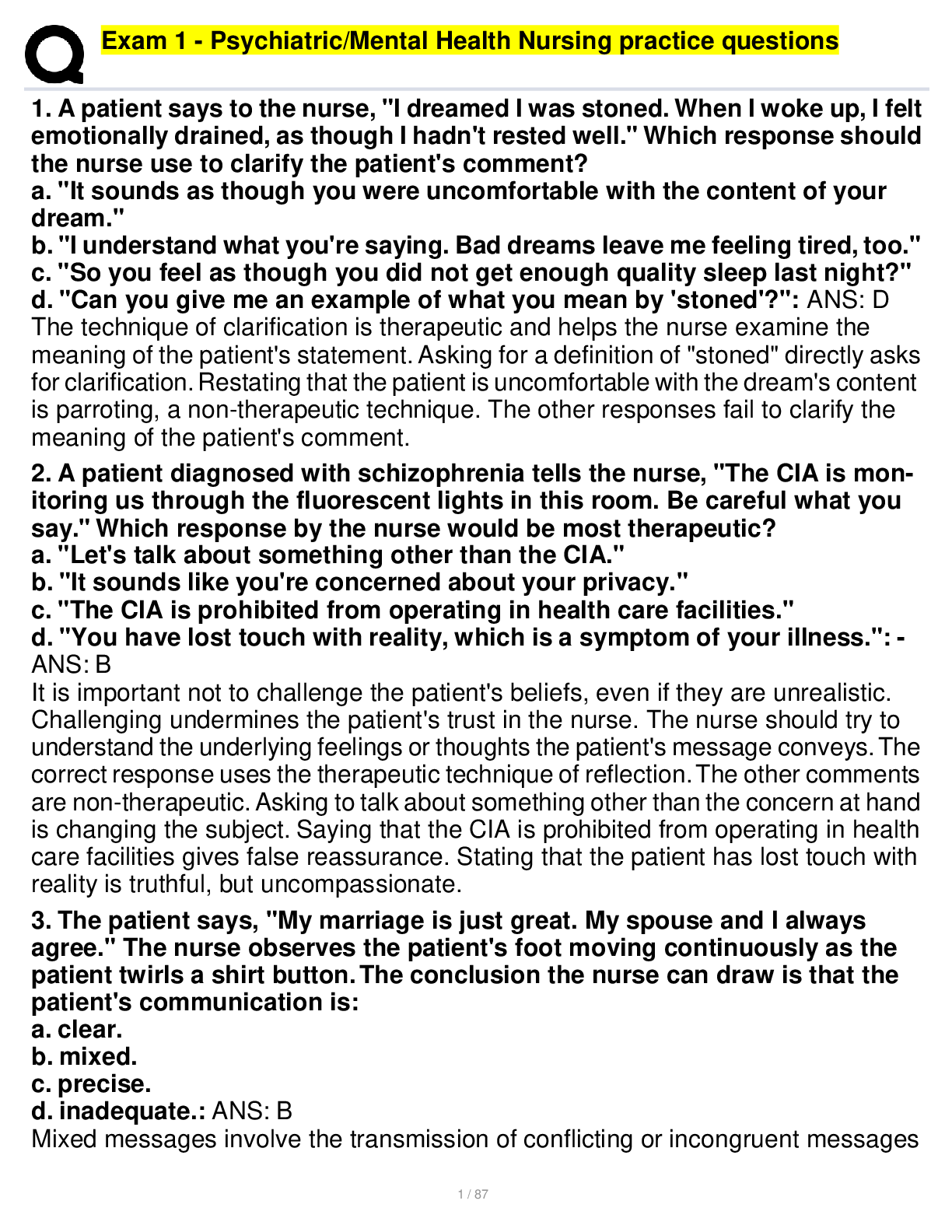
Reviews( 0 )
Document information
Connected school, study & course
About the document
Uploaded On
Oct 26, 2022
Number of pages
87
Written in
Additional information
This document has been written for:
Uploaded
Oct 26, 2022
Downloads
0
Views
64


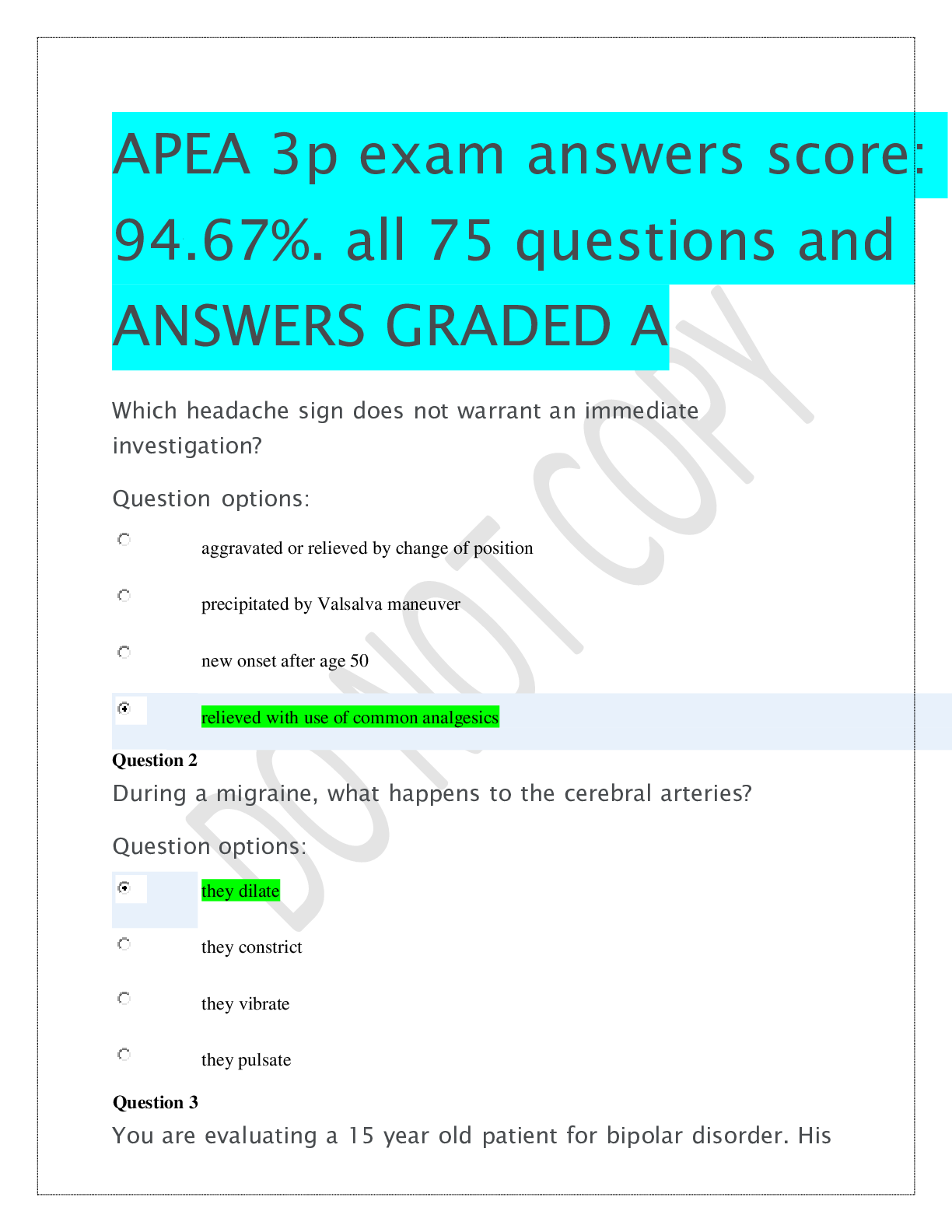


.png)
.png)

